Green mambas and king cobras are among the most feared snake species in the world. The interesting thing is that they share some similarities – for instance, they are both diurnal and arboreal snakes. Besides, they are highly venomous snakes that are often avoided. However, they also have a lot of differences. In this article, we’ll learn the key differences between a green mamba vs a king cobra.
Now, let’s get to it.
Comparing a Green Mamba and a King Cobra
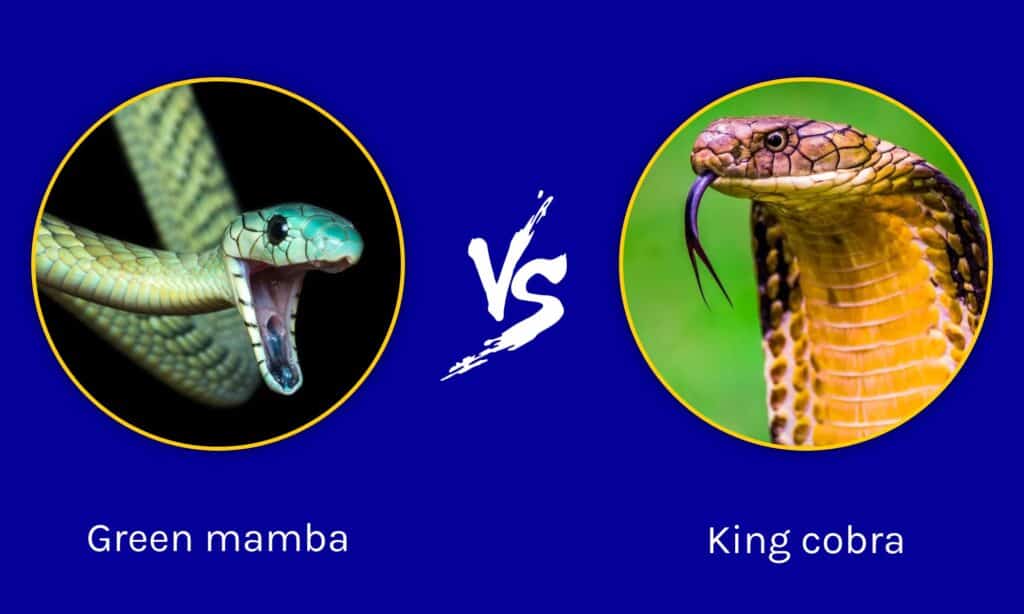
| Green Mamba | King Cobra | |
|---|---|---|
| Size & Weight | Weight: weighs up to 13 pounds. Length: average length is about 4 feet to 7 feet. | Weight: weighs up to 4 pounds. Length: average length is about 11 feet to 13 feet. |
| Genus | Belongs to the Ophiophagus genus | Belongs to the Dendroaspis genus |
| Morphology | Apart from the eastern green mamba, other species cannot flatten their heads to reveal a hood. Are typically green in color. | Can flatten its head to reveal a hood when the head is raised. Color varies from brown to yellow to green. |
| Distribution & Habitat | Are found in Eastern, Western, and Central parts of Africa. | Are found in Southern and South-East Asia. |
| Diet | They are opportunistic eaters that hunt on a variety of prey, including birds, rodents, squirrels, e.t.c. | They are picky eaters and often stick to a diet of other snakes. |
| Behavior & Venom | They protect themselves by camouflaging themselves with their environment. Their venoms can kill within 45 minutes. | They protect themselves by remaining still whenever they perceive predators. Their venom can kill in 30 minutes. |
The Key Differences Between A Green Mamba and a King Cobra
The key differences between green mambas and king cobras are their size, weight, morphology, distribution, diet, and venom. Typically, a green mamba is smaller and less heavy than a King Cobra. Besides, while king cobras have hoods on their heads, green mambas, apart from the eastern green mamba, don’t have hoods when their heads are raised. But what other differences exist between these two snake species? Let’s find out in detail.
Green Mamba vs King Cobra: Size & Weight
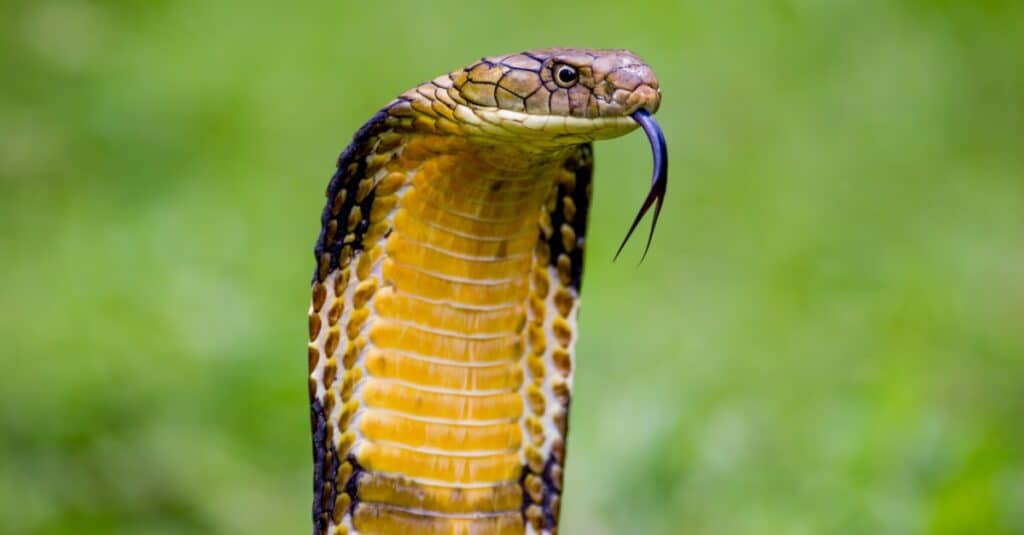
The king cobra is the longest venomous snake.
©iStock.com/takeo1775
Green mambas and king cobras are generally long snakes. However, the king cobra is longer and heavier than a green mamba. The green mamba is typically between 4 to 7 feet long. For green mambas, differences in length vary on species. The three green mamba species are the eastern green mamba, the western green mamba, and Jameson’s mamba. Of these three species, the eastern green mamba is the longest, with an average length of 5 feet to 7 feet. Green mamba hatchlings are usually between 1.3ft and 1.5ft long.
On the other hand, the king cobra is about twice as long as a green mamba. The average length of a king cobra varies between 11 feet to 13 feet. But the interesting thing is a king cobra can grow up to 18 feet. It is, however, recorded that the largest of this species grew as long as 19 feet. They also weigh as much as 13 pounds, although green mambas don’t usually weigh more than 4 pounds. With the length and weight advantage they have coupled with their venom, king cobras are one of the most dangerous snakes in the world.
Green Mamba vs King Cobra: Morphology
Green mambas are usually green in color but have yellow bellies. They are one of the snake species that have their bodies covered with scales or scutes. These scutes are usually of a lighter tone than the rest of their skin. The head of a green mamba is as narrow as its body. But instead of having a tape-like shape like the rest of their body, they have a coffin-shaped head. Their black eyes are conspicuous because of their light skin tone. Unlike the other species, the eastern green mamba has the distinct ability to flatten its neck without forming a hood when under threat.
In contrast, a king cobra’s skin tone varies from brown to green to yellow. Like the green mamba, their skin is protected by scutes. However, the color of their scutes depends on their skin color. What does this mean? A brown king cobra will typically have brown scutes whereas a yellow king cobra will have yellow scutes.
One of the distinct physical features of a king cobra is the yellow/white V-marking that is evenly distributed across its long body. King cobras have heads of the same width when in their normal shape. However, they can flatten their heads from the lower neck while raising them, especially when they attack. Under their heads is a variegating shade of white, yellow, and brown.
Green Mamba vs King Cobra: Distribution & Habitat
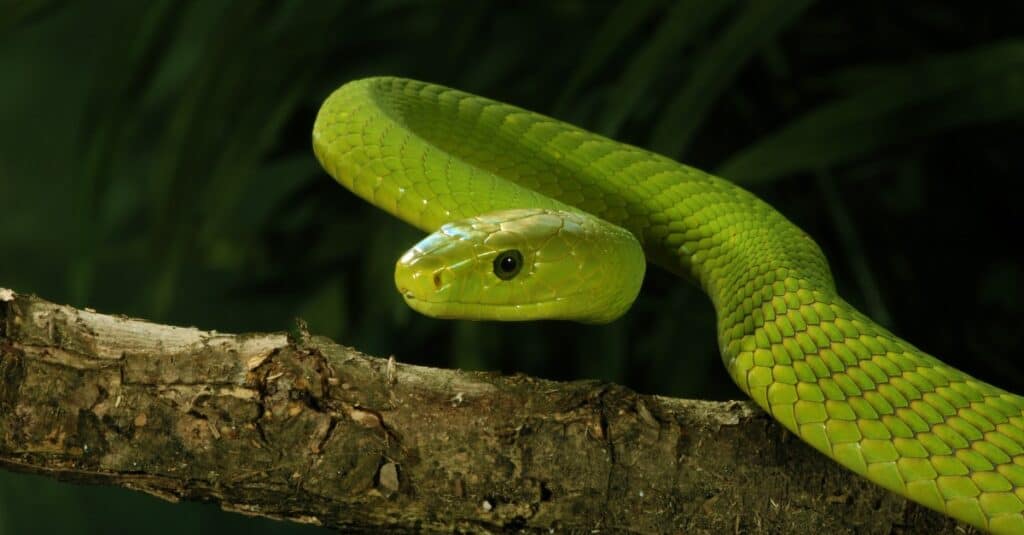
Green mambas have short, fixed fangs at the front of their mouths.
©iStock.com/through-my-lens
The different species of green mambas are natives of separate regions of Africa. Although all species belong to the Dendroaspis genus, the eastern green mamba is indigenous to southern Africa. They are usually found near coastal areas of South Africa, Tanzania, Kenya, Eastern Zimbabwe, Southern Malawi, and Kenya. Western green mambas are found in West Africa, especially in Senegal, Gambia, Benin Republic, Togo, Nigeria, and a few neighboring countries. The Jameson mambas are natives of West and Central Africa. They are more commonly found around the coasts and tropical rainforests of the Republic of Congo, Central African Republic, and the Democratic Republic of Congo.
However, the king cobra is indigenous to Southern and Southeast Asia countries. They are commonly found in streams, forests, and swamps of Hong Kong, China, the Philippines, Eastern Indonesia, and Western Indonesia.
Green Mamba vs King Cobra: Diet
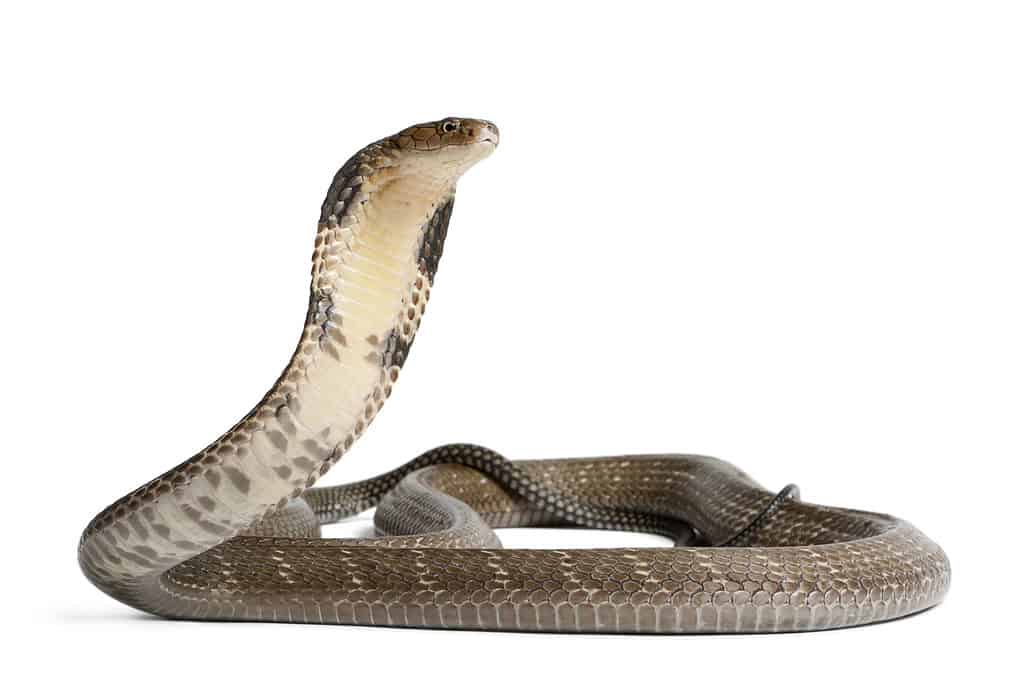
What makes these cobras kings is not just their size, or their deadliness, it is that they eat other snakes.
©Eric Isselee/Shutterstock.com
Green mambas and king cobras are carnivores, although the latter are very picky eaters. Green mambas are opportunistic eaters. Their diet consists of small reptiles, birds, rodents, frogs, and other small animals they might find on land. They also eat eggs produced by different types of birds.
Being picky eaters, king cobras are notorious as predators to cold-blooded animals, especially other snakes. They are very specific with their diet and sometimes may only hunt particular species of snakes for food. Both snake species usually hunt down their prey and then attack them with their venom to weaken or kill them before devouring them.
Green Mamba vs. King Cobra: Behavior & Venom
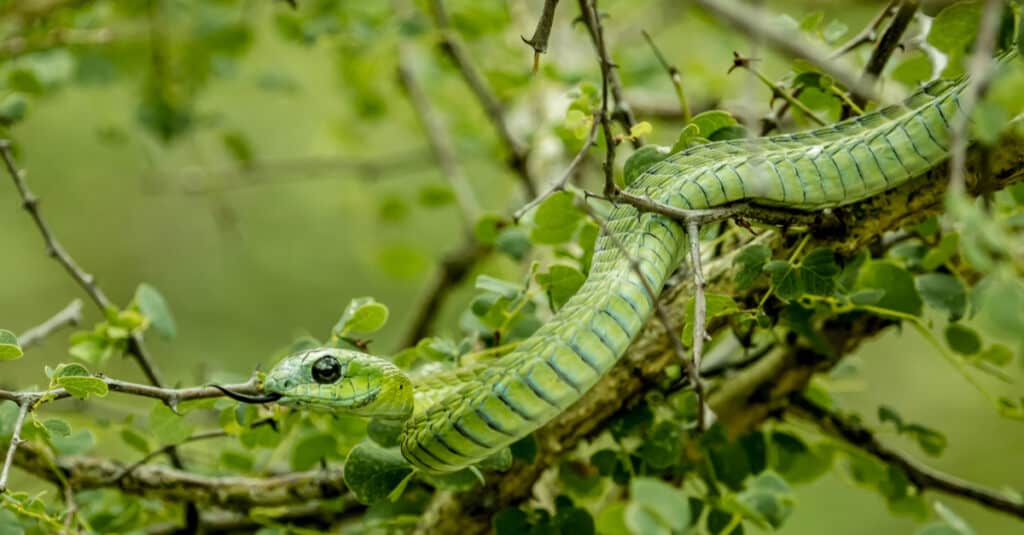
Green mambas camouflage with green vegetation to hide from predators.
©OrodO/Shutterstock.com
Generally, green mambas are a venomous species, yet they are not considered to be inherently aggressive. However, when under threat, they may attack aggressively. Reports of them biting humans are low. Nonetheless, their venom is highly fatal and without proper medical attention, can lead to death in 45 minutes. For protection, they rely on their green skin tone and would camouflage with green vegetation to hide from predators.
Similarly, king cobras hardly attack people. However, their bites are highly fatal and can, interestingly, kill faster than that of a green mamba. Without proper medical attention, a bite from a king cobra can kill its victim in 30 minutes. Unlike green mambas, they may not be able to camouflage properly with their environment. So for protection, they often remain still to prevent their predators from detecting them.
The photo featured at the top of this post is © KitThanit/Shutterstock.com
Discover the "Monster" Snake 5X Bigger than an Anaconda
Every day A-Z Animals sends out some of the most incredible facts in the world from our free newsletter. Want to discover the 10 most beautiful snakes in the world, a "snake island" where you're never more than 3 feet from danger, or a "monster" snake 5X larger than an anaconda? Then sign up right now and you'll start receiving our daily newsletter absolutely free.
Thank you for reading! Have some feedback for us? Contact the AZ Animals editorial team.






